|
The Ancient Native American Southwest
The panoramas in this collection cover
just a few of the many sites in the American Southwest where Native American
communities thrived many hundreds of years ago. The remains of their
skillfully engineered pueblos and cliff dwellings, many of which are over a
thousand years old, offer testimony to the expertise of the builders and the
sophistication of the vibrant cultures they were part of.
Click on the images below to bring up
the first panorama for the location and then click on that panorama’s hot
spots to view additional content. For some locations, clicking on the image
below brings up an intermediate map with hotspots for accessing the
location’s panoramas.
When viewing and visiting these
fascinating sites, please keep in mind that these locations hold great
spiritual significance to many present day Native Americans and should be
treated with the utmost respect.
Ancestral
Puebloan Culture
The Ancestral Puebloan people lived in
the “four corners” region of south-east Utah, south-west Colorado,
north-eastern Arizona, and northern New Mexico. The roots of this culture may
be traced back as far as the 12th century BC but the many
beautiful cliff dwelling and pueblo complexes they produced between 900 AD
and 1350 AD have brought them the most renown. Also of note are the great
roads they constructed during that period to link their cultural center at
Chaco with their other communities. Although sometimes called the Anasazi,
use of that term is discouraged by current-day Puebloans because it is a
Navajo word meaning “ancient enemy”. You can learn more about the Ancestral
Puebloan culture on Wikipedia.
|

|
Aztec Ruins
National Monument
Aztec, New Mexico
4 panoramas
This national monument showcases
the remains of a 500-room pueblo built by the Chacoans a little after 1100
AD. It hosts the only re-roofed great kiva in the southwest. You can learn
more by visiting the Monument’s website
or Wikipedia.
|
|
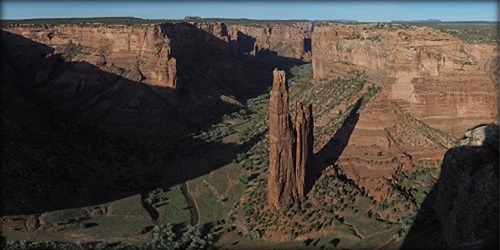
|
Canyon de Chelly
National Monument
Chinle, Arizona
10 panoramas
Although currently the home
of the Navajo, Ancestral Puebloans built and farmed in spectacular Canyon
de Chelly as far back as 1300 AD. The remains of many of their cliff houses
and ground level pueblos can still be seen. You can learn more by visiting
the Monument’s website
or Wikipedia.
|
|
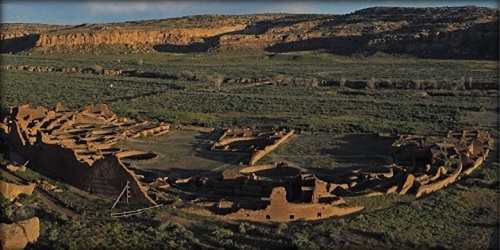
|
Chaco Culture
National Historical Park
New Mexico
15 panoramas
A UNESCO World Heritage
site, Chaco Culture National Historical Park preserves and protects what
was a major cultural center of the Ancestral Puebloan peoples a thousand
years ago. Multiple ancient building complexes line the canyon. You can
learn more by visiting the park’s website or Wikipedia.
To view the structures from above, click on the panorama’s map icon and
zoom in on the satellite view.
|
|
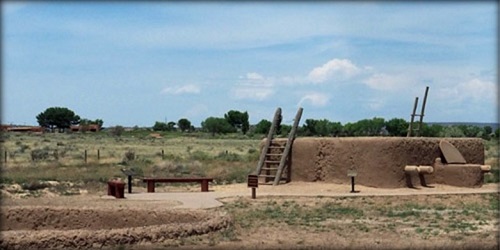
|
Coronado Historic
Site
Bernalillo, New Mexico
1 panorama
The Coronado Historic
Site preserves the remains of the Kuaua Pueblo, which was founded around
1300 AD and was home to over a thousand people. The site is named after the
Spanish explorer Coronado, whose 1540 expedition preyed upon this and other
nearby Native American communities, leading to the Tiguex War. You can
learn more about the Coronado Historic Site by visiting the park’s website or Wikipedia.
|
|
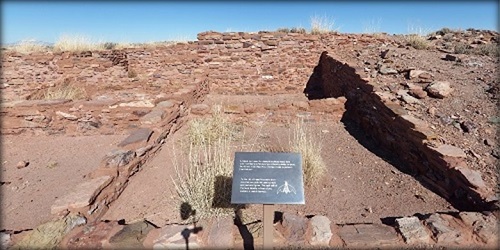
|
Homolovi State
Park
Winslow, Arizona
17 panoramas
This park preserves Ancestral
Hopi village sites which thrived between about 1200 AD and 1400 AD. The
modern-day Hopi consider the Ancestral Puebloans to be their ancestors.
Learn more about Homolovi State Park by visiting the park’s website or Wikipedia. The
former includes an excellent audio tour. If you would like to listen to it
while you view the panoramas, click “here”
to bring up the park page, then start the audio, bring up the first
panorama, and follow the directions in the panorama “Information” boxes to
keep the panoramas in sync.
|
|
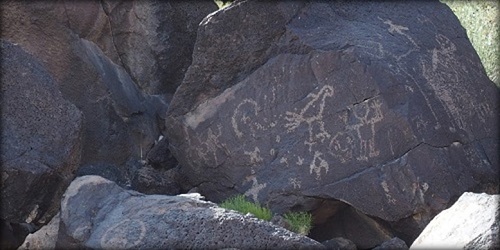
|
Petroglyph
National Monument
Albuquerque, New Mexico
1 panorama
This national monument
presents an odd juxtaposition of the ancient and modern. Rock formations
with petroglyphs that are many hundreds of years old sit like an island in
a sea of suburban housing developments. You can learn more by visiting the
Monument’s website or Wikipedia.
|
Sinagua
Culture
The people we call the Sinagua lived
in central Arizona from about 500 AD to about 1425 AD. Skillful builders,
they left behind cliff dwellings, pueblo-style great houses, and lesser
pit-style houses. As craftsmen, farmers, and traders, they interacted with
their Puebloan neighbors to the north and the Hohokam to the south, sometimes
adopting their building techniques and cultural traits. You can learn more
about the Sinagua on Wikipedia.
|
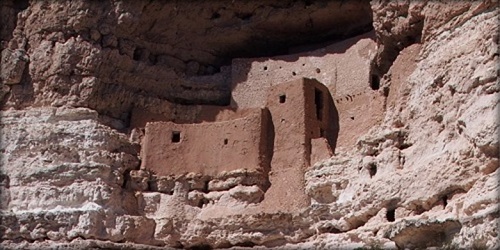
|
Montezuma Castle
National Monument
Camp Verde, Arizona
11 panoramas (cylindrical)
Montezuma Castle is a
Sinaguan cliff-dwelling located in Central Arizona. Despite being nearly a
thousand years old, it is one of the best-preserved structures of its kind.
Reflecting the site’s importance, it was one of the nation’s first national
monuments. You can learn more by visiting the Monument’s website or Wikipedia.
|
|
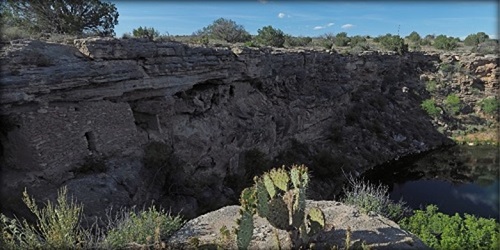
|
Montezuma Well
Camp Verde, Arizona
1 panorama
This striking natural
limestone sinkhole is administered as part of Montezuma Castle National
Monument. Spring fed even during times of drought, ancient Sinaguan farmers
built a seven-mile canal to channel the Well’s outflow to their fields.
They also built the rock rooms still visible in the Well’s rim. The Well is
sacred place for the present-day Yavapai people. You can learn more about
Montezuma Well by visiting the Monument’s website
or Wikipedia.
|
|
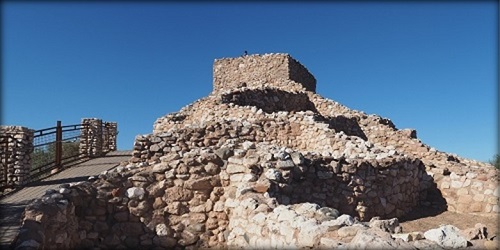
|
Tuzigoot National
Monument
Clarkdale, Arizona
5 panoramas
Rising over the Verde River
valley, this 110-room hilltop Sinaguan pueblo was an important center for
both agriculture and trade from about 1100 AD to 1400 AD. Over the centuries, the elements reduced
the structures to ruins but the walls and tower we see today were rebuilt
during the Great Depression under the direction of the Federal Works
Project Administration. You can learn more by visiting the Monument’s website or Wikipedia.
|
|
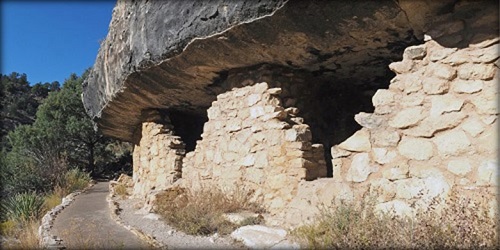
|
Walnut Canyon
National Monument
Flagstaff, Arizona
7 panoramas
The beautifully forested
walls of Walnut Canyon shelter the remains of over 80 small cliff
dwellings. They were built by the Sinaguan community that made the canyon
their home from about 1100 AD to 1250 AD. As you scan the steep sides of
the canyon, see how many you can spot tucked away in their natural alcoves.
Follow the Island Trail to see some of these ingeniously engineered rooms
up close. On the rim of the canyon, the remains of above ground pueblo
structures and older pit houses can be found. You can learn more by
visiting the Monument’s website
or Wikipedia.
|
|
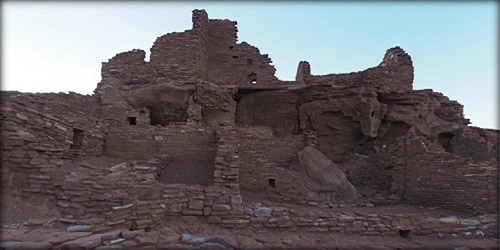
|
Wupatki National
Monument
Flagstaff, Arizona
6 panoramas
This national monument
preserves and protects the remains of several Native American communities
which farmed the area over 800 years ago. An eruption at nearby Sunset
Crater was a boon to the farmers, with the ash falls replenishing the soil.
The largest of the villages in the area was the 100 room Wupatki Pueblo,
which was built around and atop a rock outcrop. The communities were also
heavily involved with trade and artifacts from both the Pacific and Gulf
coasts have been found here. You can learn more by visiting the Monument’s website or Wikipedia.
|
Hohokam
Culture
The Hohokam culture thrived in central
and southern Arizona for over fourteen hundred years, ending around 1450 C.E.
Beginning around 800 C.E., they were building systems of very sophisticated
and well-engineered irrigation canals to support their agricultural efforts.
By about 1300, it is estimated that their people formed the largest
population group in the Southwest. Their dwellings included impressive
multi-story pueblo buildings. You can learn more about the Hohokam culture on
Wikipedia.
|
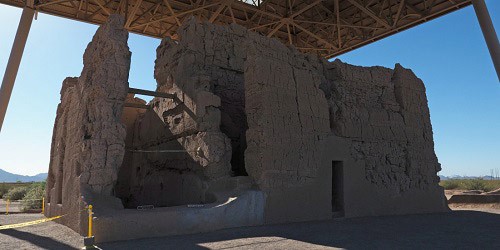
|
Casa Grande
National Monument
Coolidge, Arizona
7 panoramas
The massive great house
found in this Gila River Valley Hohokam community was four stories tall. It
is just part of a much larger village complex that existed at this location
from around the sixth century until the mid-1400s. In 1892, the importance of the site resulted
in it being named the first archeological preserve in the U.S. It became a
national monument in 1918. The protective roof structure was built in 1932.
You can learn more by visiting the Monument’s website or Wikipedia.
|
|
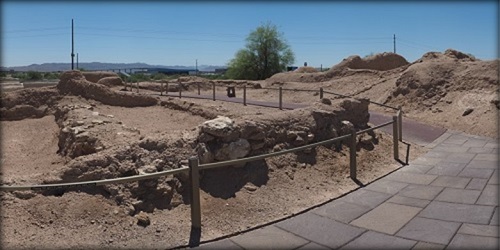
|
Pueblo Grande
Museum and Cultural Park
Phoenix, Arizona
6 panoramas
A National Historic
Landmark, Pueblo Grande was the site of a major Hohokam community that
thrived for about a thousand years, beginning around 450 C.E. Located in
downtown Phoenix, the park includes a first-class museum and preserves the
remains of a major Hohokam platform mound and a ballcourt. There are also
re-creations of the ancient Hohokam houses. You can learn more by visiting
the park’s website
or Wikipedia.
|
Salado Culture
The people we call the Salado farmed, hunted,
and traded in south-eastern Arizona in an area called the Tonto Basin for
about 300 hundred years, starting around 1150 C.E. They are noted for their
beautiful polychrome pottery. They lived in ground level walled pueblos and
also in cliff dwellings. You can learn more about the Salado culture on Wikipedia.
|
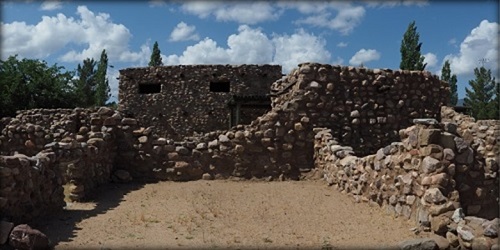
|
Besh-Ba-Gowah
Archaeological Park
Globe, Arizona
4 panoramas
As one of the museum exhibits states: “Besh Ba Gowah is a 200 room prehistoric
Salado masonry pueblo occupied between A.D. 1225 and A.D. 1400.” The
stone walls were originally plastered. A model in the museum recreates the
original appearance. The name of the park comes from the Apache words for
“place of metal”, a reference to the mining that took place in early Globe.
You can learn more by visiting the park’s website or Wikipedia.
|
|
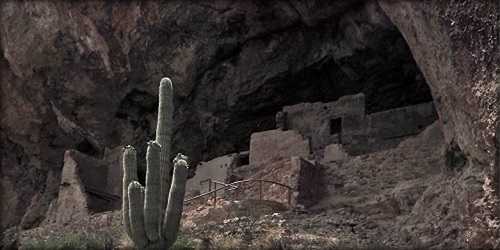
|
Tonto National
Monument
Globe, Arizona
4 panoramas
Tonto National Monument
preserves the remains of two ancient Salado cliff dwellings. Currently, the
panoramas on this site cover only one of them: the Lower Ruin. You can
learn more by visiting the Monument’s website or Wikipedia.
|
Other Cultures
|

|
The Blythe
Intaglios
Blythe, California
9 panoramas
The Blythe intaglios are
huge figures that were scraped into the desert surface by Native Americans
hundreds, perhaps even thousands, of years ago. You can learn more about
them on Wikipedia.
Note: to view the figures from above, click on the panorama’s map icon and
then zoom in on the satellite image until the figures become visible. Also,
be sure to read the three informational signs.
|
Recommended Reading
A.D. 1250, Ancient Peoples of the Southwest
By Lawrence W. Cheek
Published by Arizona Highways, 1994
1491: New Revelations of the Americas Before Columbus
by Charles C. Mann
Published by Alfred A. Knopf, 2005
|
















